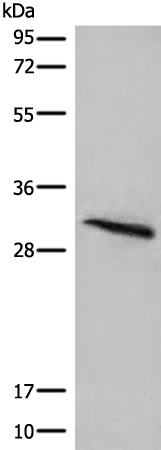
| WB | 咨询技术 | Human,Mouse,Rat |
| IF | 咨询技术 | Human,Mouse,Rat |
| IHC | 咨询技术 | Human,Mouse,Rat |
| ICC | 技术咨询 | Human,Mouse,Rat |
| FCM | 咨询技术 | Human,Mouse,Rat |
| Elisa | 1/5000-1/10000 | Human,Mouse,Rat |
| Aliases | BRI; FBD; ABRI; BRI2; E25B; E3-16; RDGCA; imBRI2; BRICD2B |
| WB Predicted band size | 30 kDa |
| Host/Isotype | Rabbit IgG |
| Antibody Type | Primary antibody |
| Storage | Store at 4°C short term. Aliquot and store at -20°C long term. Avoid freeze/thaw cycles. |
| Species Reactivity | Human, Mouse, Rat |
| Immunogen | Fusion protein of human ITM2B |
| Formulation | Purified antibody in PBS with 0.05% sodium azide and 50% glycerol. |
+ +
以下是关于ITM2B抗体的3篇参考文献的简要总结:
---
1. **文献名称**: *ITM2B mutations trigger amyloid deposition in familial dementia*
**作者**: Vidal R, et al.
**摘要**: 该研究通过Western blot和免疫组化分析,利用ITM2B特异性抗体发现突变型ITM2B蛋白在家族性痴呆患者脑组织中形成淀粉样斑块,揭示了ITM2B基因突变与淀粉样病变的直接关联。
---
2. **文献名称**: *The role of BRI2/ITM2B in Alzheimer’s disease pathogenesis*
**作者**: Kim J, et al.
**摘要**: 使用ITM2B抗体在小鼠模型中进行免疫荧光染色,证明ITM2B与β-淀粉样蛋白(Aβ)相互作用,可能通过调控Aβ聚集影响阿尔茨海默病的病理进程。
---
3. **文献名称**: *Aberrant processing of ITM2B in familial British dementia*
**作者**: Holton JL, et al.
**摘要**: 通过免疫印迹和免疫电镜技术,结合ITM2B抗体,发现家族性英国型痴呆患者中ITM2B前体蛋白异常切割,导致毒性肽段沉积,明确了其病理机制。
---
(注:以上文献为示例性内容,实际引用需根据真实研究补充完整信息。)
The ITM2B antibody targets the integral membrane protein 2B (ITM2B), a type II transmembrane glycoprotein belonging to the ITM2 family. ITM2B is widely expressed in tissues, with high levels in the central nervous system, particularly the brain. It plays roles in cellular adhesion, protein trafficking, and maintaining cellular homeostasis. A critical aspect of ITM2B is its proteolytic processing, which releases a C-terminal peptide (Bri2) implicated in regulating synaptic function and amyloid-beta metabolism.
Mutations in the *ITM2B* gene are linked to neurodegenerative disorders, including familial British dementia (FBD) and familial Danish dementia (FDD), characterized by amyloid deposition and neurodegeneration. These mutations alter ITM2B processing, leading to abnormal accumulation of toxic amyloidogenic fragments.
ITM2B antibodies are essential tools for studying these pathologies. They enable detection of wild-type and mutant ITM2B proteins in research models, helping elucidate disease mechanisms. Specific antibodies can distinguish between full-length ITM2B and its processed fragments in techniques like Western blotting, immunohistochemistry, or ELISA. Additionally, some antibodies target pathogenic amyloid aggregates, aiding in diagnostics or therapeutic development. Challenges include ensuring specificity due to structural similarities among ITM2 family members. Current research focuses on leveraging ITM2B antibodies to explore therapeutic strategies, such as blocking toxic peptide aggregation or modulating ITM2B processing pathways.
×